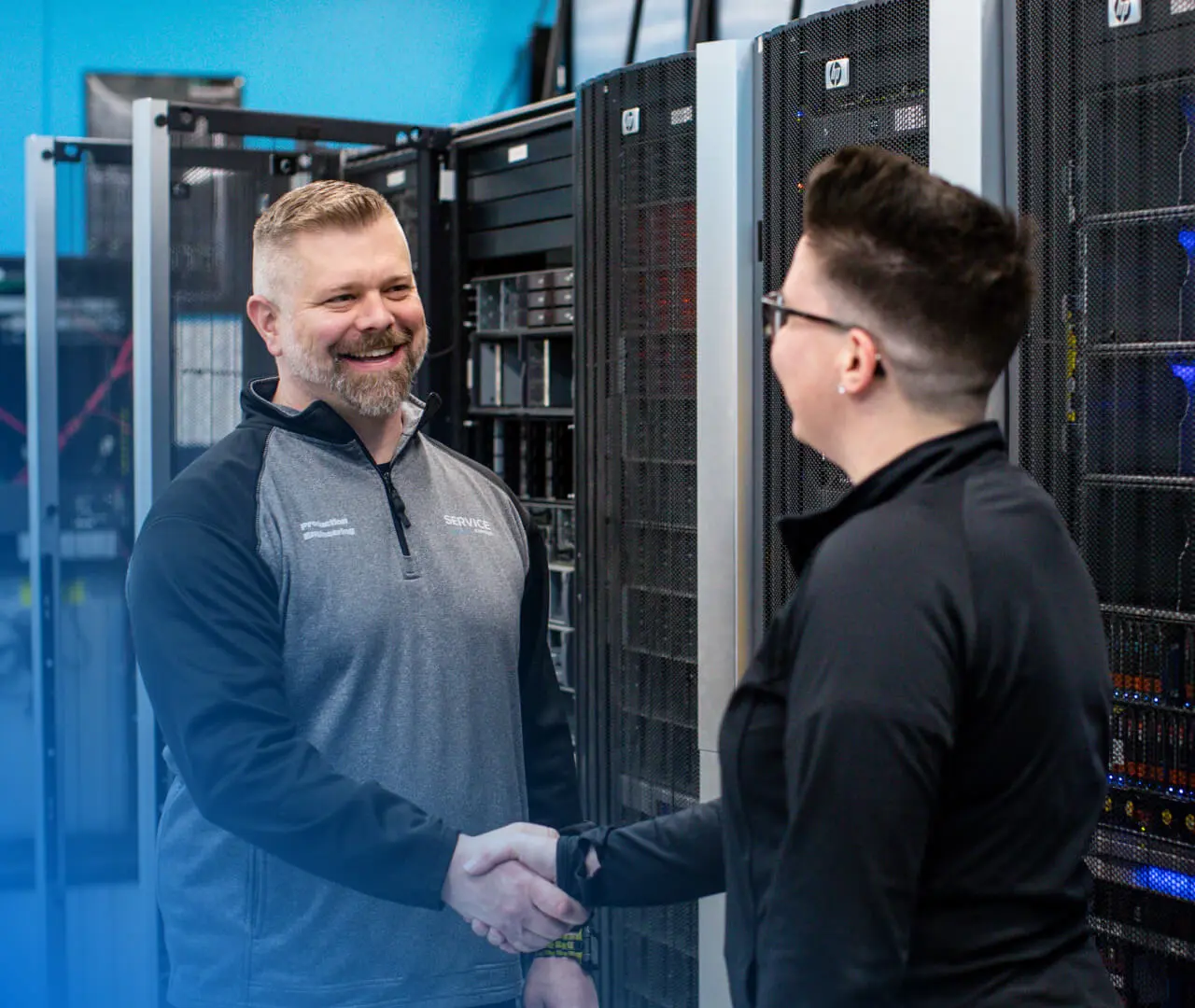Conferences, volunteering and maximizing your value
Before the conference
Focus on growth
Growth should be the goal for anyone attending a conference. Having a narrow scope of things to learn is the antithesis of growth. The track has been narrowed, and the blinders are on. You’re only going to see what you’ve been directed to see. That’s not growth; that’s receiving instruction. That’s coloring inside the lines with a predetermined couple of crayons. You must learn about things you know nothing about. Otherwise, what’s the point of going?
I remember my now colleague and fellow IBM Champion Larry Bolhuis doing an entire 75-minute session on the Change IPL Attributes (CHGIPLA) screen. It’s one screen! I had done hundreds, if not thousands, of IPLs by then. I figured if Larry was going to talk about one screen for 75 minutes, there must be more to it than what I knew. And that was exactly the case. Start by focusing on what you don’t know or only think you know.
Set expectations
This one is for the managers sending people to conferences. Sometimes, people attend a conference expecting to answer emails, voicemails, texts and Teams messages during downtime. However, that’s when growth happens: the unexpected conversations during meals or breaks where attendees pick up the real gems. Even if they don’t get a gem, they may get a good idea to pursue when they return. And hopefully, they’ve spoken to the presenter and made a new contact.
So, if you’re sending people to a conference, then make sure there’s backfill and the expectation is that they’re going for the entire experience, not just to take in 14 or 15 narrowly focused sessions. If you want a narrow focus for an attendee, buy them a manual or sign them up for a specific course. Take the leash off. You’ll be surprised what a knowledge-hungry sponge picks up.
Choose your sessions wisely
Attend sessions on subjects you know nothing about and consider how you can apply them. I recently had a developer reach out to me saying they didn’t know if they’d get something of value from my recent three-hour security session, but they attended anyway and were glad they did. That’s probably one of the best compliments I could receive as a speaker.
Developers with fundamental security literacy are super important. They can ensure that the things they put in production follow a standard or are at least not wide open. The last thing I’d want as a developer is to put a new table full of secure information into production that wasn’t actually secured.
Remember to have an open mind even if you see a session topic outside your day-to-day work. You may come away with something you can use to take your work to the next level.
Pack the necessities
Bring socks. Lots of socks. Good socks. I bring two pairs for each conference and travel day. A five-day conference? Bring ten pairs with an extra pair for good measure. Change into fresh socks after lunch or dinner. I’m dead serious. And don’t forget to wear some comfortable shoes that are well-loved. Don’t buy new dress shoes the week before. Your feet will get a workout, and the last thing you want to do during a conference is to break in new shoes. Remember, you’ll be going through airports and wearing them on flights, too. Take care of your feet because nobody else will do that for you.
Bring a mini drugstore in your bag — antacids, painkillers, nail clippers, saline solution, bandages or anything else you might need. I remember a few conferences in Austin and San Antonio where we ate Tex-Mex daily for a solid week. A bottle of Tums or Rolaids is well worth the additional travel weight when heartburn hits at 2 a.m.
Bring a power strip. It never hurts to have the ability to extend your power. Depending on the hotel room setup, your power options will vary drastically. Even more so if you’re presenting.
Bring a laser pointer because I almost always forget one of mine, and I will likely be hunting for a spare. Your cooperation is appreciated, and I’ll be your new friend.
At the conference
Prepare for success
I tend to unpack, iron and hang my clothes immediately when I get to my hotel room. Get it done first and once. Don’t waste time ironing in the morning when you could be networking over breakfast. Get up early, shower, put on your badge and get out the door without a care in the world and an open mind.
Help by volunteering
The foundation of any community is the volunteer effort. Most often, presenters aren’t compensated for their time. Vendors at the expo aren’t compensated for their time. Everyone gives something to be there — their time, sponsorship dollars or both — and wants the conference to be a huge success. That’s why volunteers go above and beyond every single time.
If you’re at the event early, find someone with a badge and ask to help. Conferences usually appear seamless on the surface and are often absolute mania below it. Ask to set up chairs or be a speaker assistant. Maybe you know audio/video to help plug in some equipment. Help fill up the conference backpacks with goodies. There’s plenty to do. Nobody is going to refuse help, especially in a volunteer-run event, and it’s a great way to see how everything works and build new relationships.
Ask questions
Ask speakers questions during the session, after the session, in the elevator, if you spot them at Walgreens, etc. That’s why they’re in town.
If you have a burning technical question, just ask anyone. At a conference, there’s almost a guarantee that the person you ask can introduce you to the person who may have the answer. Often, there are panels with a named moderator. If you’re too shy to take the mic and ask in front of a couple hundred people, find the moderator in advance and give them your question. That’s what they’re there for. Be sure to attend the panels.
Network with vendors
Go to the expo and meet every vendor. Get their souvenirs, stress balls and t-shirts. Yes, they’ll likely contact you afterward. I’ve experienced the expo as a customer and as a vendor. As a customer, you might not be able to use the product or solution today or tomorrow, but you can pass it along to someone down the road who may be in the market for it. Additionally, the vendor may give you solid advice you can use immediately. Not everyone at the expo is there to sell a product per se. They’re there as a vendor to show what they can do for you, not what they can sell you on.
I remember I went to an IBM Lotus conference as a customer in 2007 and attended a Domino performance session. I was having performance problems and asked what the speaker thought while visiting his booth at the expo. He gave me simple and solid tech advice. I went back home, and it immediately fixed my problem. I didn’t buy anything, and he didn’t sell me anything. But I remembered his name. Several months ago, I saw him post on a Facebook group question, so I thanked him nearly 20 years later. I’ve even sent people to his company for different solutions over the years.
Vendors have so much value to share with the community. There’s give and take. They do more than just sponsor events. And you never know when a contact like that will come in handy.
Attend social events
Don’t stay in your hotel room. Conferences are full of introverts, especially in the tech world. Get out of that comfort zone as best you can. Find out which social events are happening and show up. I guarantee you’ll make far better use of your time than scrolling through your phone alone in your room every night.
Conference attendees often wear badges well into the night to identify themselves. Find a group or even someone standing alone and introduce yourself. You’ll be surprised how fast people accept you because they’re often afraid to make the first move themselves.
Speaking of introverts, I’m very much an introvert who’d be happy most days not talking to anybody. I’m an “extrovert on the outside” after years of practice, and most people can’t tell now. It’s paid off because of the friends and contacts I’ve made at conferences.
Provide feedback
Be sure to give honest session feedback. Good speakers are constantly fine-tuning and changing their sessions. They’re always wondering if their content is too easy or difficult or if they’re talking too fast or slow. Did you expect 75 minutes of solid content and only get 30 minutes of decent content with 45 minutes of irrelevant banter? Did you go to a technical session but were disappointed when it turned into a product marketing session? Did you feel engaged? Did a speaker miss the mark entirely? What were your expectations, and did it match the session title and abstract?
Fill out feedback sheets or online surveys. Tell the presenter face-to-face what you think. You’d be surprised how much a little constructive feedback helps shape their next effort. Moreover, you may get some immediate value from them one-on-one because they’ll likely want to make it right and send you home happy. And be sure to tell speakers what they got right, too. We like to hear we’ve made people happy.
After the conference
Consider becoming a presenter
If you think you can present a session, submit one for consideration! It’s not rocket science — you’re just telling a story. That’s all a presentation is when you boil it down. Just present what you know. If I do a session on penetration testing an IBM i, you’ll get exactly that from start to finish. If I do what I call Rapid Fire Admin, it’s me stapling you to the wall with 150 tips in 75 minutes. Pick your title and abstract, then tailor your content to match it. It’s very straightforward.
Presenting will often help with your travel and hotel costs. You bring formal value. Why do you think I started speaking to begin with? It’s not because I loved standing up in front of people with a microphone. When I started, I was terrified. Presenting what I knew and sharing my stories helped me grow professionally and as a public speaker. Most importantly, it reduced my company’s cost to send me for education as a customer.
Share your knowledge
Lastly, share what you’ve learned and the value you received with your company after you come home. Tell them who you’ve met and what tips you picked up that will save your company time and money. It’ll make the next conference far easier to get approved if they understand it’s an investment, not an expense.
Put these tips to work! Use what you’ve learned from this blog to join us at an upcoming event.
How to prioritise data centre sustainability and carbon avoidance
As many countries continue to strive toward net neutrality in 2025 as outlined by The Paris Agreement, companies are occupied with evaluating their value chains, carbon outputs, use of finite resources and more.
When identifying areas to reduce carbon emissions, it’s common to focus on the automotive, manufacturing and transportation industries. However, looking at the IT and data centre industry is equally important. McKinsey forecasts that the demand for data centres in the United States will grow around 10% annually until 2030. A steady increase in the need for data centres means more equipment manufactured and transported, leading to increased carbon emissions.
Understanding the carbon impact of your data centre equipment can improve operations, strategies, processes and, ultimately, your sustainability goals.
- Corporate sustainability reporting
- What is a circular economy?
- What are carbon emission scopes?
- The environmental impact of data centre equipment
- How to address carbon avoidance in your data centre
- The next step on your data centre sustainability journey
Corporate sustainability reporting
The European Union’s Corporate Sustainability Reporting Direction (CSRD) took effect in January 2023. The directive requires companies to disclose detailed reports on Scope 1, 2 and 3 emissions as outlined by the 12 European Sustainability Reporting Standards (ESRS). Currently, the directive applies to companies operating in Europe and US-based companies with subsidiaries in Europe that meet specific criteria. Although sharing detailed information regarding carbon emissions and sustainability initiatives isn’t required across the board, it’s a step in the direction many countries are heading.
Now is the time for companies to understand their carbon footprint, sustainability goals and potential improvements to prepare for what’s to come. One of the many ways to do so is by adopting circular economy principles.
What is a circular economy?
Circular economy is the practice of slowing down the production and consumption of new materials by reusing, repairing and extending the life of existing materials. Decreasing the creation and consumption of new materials reduces waste, use of natural resources and greenhouse gas emissions (GHG).

In addition to adopting a circular strategy, understanding carbon emissions scopes and what falls into each category is equally important.
What are carbon emission scopes?
The Greenhouse Gas Protocol established scopes in 2001 to categorise the carbon emissions companies create in each area of their supply chain. GHG Protocol examines Scopes 1, 2 and 3.

Scope 1: Direct emissions
Scope 1 consists of direct emissions from a company’s activities and operations. Examples include company vehicles, facilities, etc.
Scope 2: Indirect emissions
(owned)
Scope 2 includes indirect emissions. A typical example includes purchasing energy or electricity to heat, cool and power facilities.
Scope 3: Indirect emissions
(not owned)
Scope 3 is one of the most challenging categories to measure because it includes indirect emissions created throughout the value chain. Examples include business travel, employee commuting, operational waste and more.
The environmental impact of data centre equipment
Understanding the impact of data centre equipment should include a holistic view of the manufacture, transport, use and end of life (EOL) phases. The image below illustrates the typical life cycle of data centre hardware from manufacturing to end of life.

Manufacture
The manufacture phase covers every step, from sourcing and mining materials to the product’s final assembly. Calculating specifics related to the manufacture phase is challenging due to the incredibly complex IT hardware value chain. One of the many factors contributing to the carbon output in this phase includes mining rare materials, such as lanthanum, cerium and europium, which are often located worldwide. In addition to mining rare metals, equipment requires specialised machines and facilities to assemble the entire system, including parts.
Transport
This phase includes distribution from the assembly site to the product’s final location.
Use
The longest life cycle phase represents the product’s operational life. This phase is measured by its electricity consumption and cooling. The use phase also includes the product’s installation, service and maintenance over time.
End of life (EOL)
This phase includes the disassembly, recycling with the help of IT Asset Disposition (ITAD) and other activities once hardware has reached the end of its useful life.
Carbon emissions created in each phase of the life cycle
The image below shows the estimated carbon emissions generated from each life cycle phase for various data centre hardware, including servers, traditional disks and SSDs.
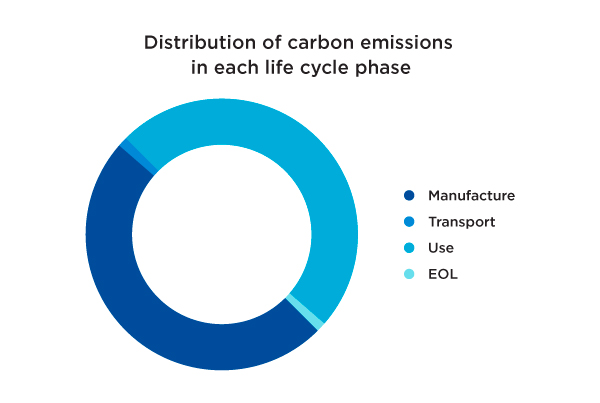
You’ll notice the carbon emissions generated in the manufacture and use phases are comparable. Although this doesn’t provide a solid conclusion regarding the climate impact of data centre equipment, it shows the use phase isn’t the only contributor to the carbon footprint of hardware.
How to address carbon avoidance in your data centre
When it comes to your data centre equipment, there are two scenarios to consider when prioritising carbon avoidance.
Option #1: Refresh hardware
Hardware refreshes are costly and take considerable time to plan and implement. Often, purchasing new hardware comes with the benefit of decreased energy usage. However, manufacturing new hardware creates 60 tonnes of CO2e, not including the transport, use and EOL phases.
For example, following a refresh cycle every 3–5 years results in manufacturing new equipment at least four times over 12 years, creating a minimum of 240 CO2e.
Option #2: Extend life of existing hardware
Using the same example as option #1, completing a hardware refresh every 6–12 years results in manufacturing new equipment approximately twice over 12 years, generating a minimum of 120 CO2e.
It’s important to note that both scenarios generate carbon emissions, but the takeaway is the difference in CO2e generated with both options. Extending equipment life cycles postpones and decreases demand for the development of new hardware, in turn decreasing carbon emissions.
The next step on your data centre sustainability journey
Prioritising data centre sustainability and reducing carbon emissions is a multifaceted approach that involves addressing each area of the product life cycle. One of the most tangible and impactful strategies to address carbon reduction is leveraging circular economy strategies, extending hardware refresh cycles and gaining a holistic view of your data centre emissions.
What’s the difference between multi, hybrid and specialty cloud?
Companies are migrating to the cloud to improve efficiency, innovation and productivity. With so many different types of cloud solutions in the marketplace today, choosing the one that best suits your organisation’s needs is crucial.
- What is multicloud?
- Benefits of multicloud
- What is hybrid cloud?
- Benefits of hybrid cloud
- What is specialty cloud?
- Benefits of specialty cloud
- What are most companies using for their infrastructure?
- Which solution is the best fit for your business?
It’s helpful to explore the differences between multicloud, hybrid cloud and specialty cloud architectures to make an informed decision for your business.
What is multicloud?
Multicloud architectures include two or more public cloud services, usually from different cloud providers. These deployments connect services across environments without physically connecting the clouds. The main objective of implementing multicloud is to give businesses the flexibility to leverage the most suitable computing environment for each of their workloads.
Software as a Service (SaaS), Platform as a Service (PaaS) and Infrastructure as a Service (IasS) all fall into the multicloud category. Most companies use these products daily, including Microsoft 365, Salesforce, AWS, etc.
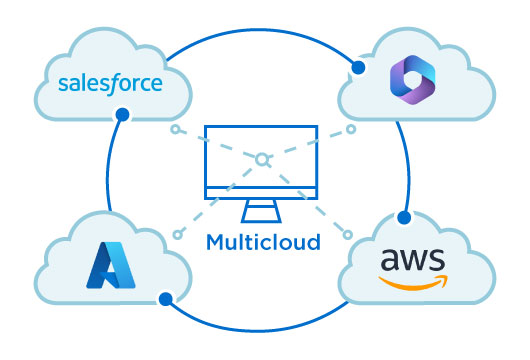
Benefits of multicloud
Cloud providers all have their own advantages and disadvantages; a multicloud solution allows you to use best-in-class services for each app or task. Partnering with multiple providers can help businesses avoid vendor lock-in and reduce expenses by opting for more affordable options.
If your business is thinking about switching to cloud computing, multicloud offers an easy and efficient setup process and can also help you:
- Minimise spending by exploring pricing options between providers
- Scale on demand to fit your organisation’s growing needs
- Reduce downtime by routing computing between clouds
What is hybrid cloud?
Both multicloud and hybrid cloud integrate more than one cloud service, but they differ in several ways. Whereas multicloud systems only use public cloud services, hybrid cloud environments combine elements of public cloud with either a private cloud or on-premises infrastructure, enabling data and application sharing between them.
Another key difference between multicloud and hybrid cloud is architecture. Those with hybrid cloud solutions own and manage a private cloud as part of their infrastructure, usually hosted on-premises or on dedicated servers within a third-party data centre. They sync their private cloud with their public cloud workloads to create a single solution.
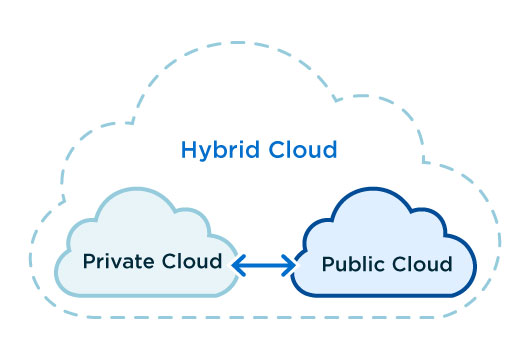
Benefits of hybrid cloud
Some organisations prefer to have their infrastructure solely onsite and don’t want to host it elsewhere. A hybrid cloud solution lets you have infrastructure in one location while using a public cloud provider to get the best parts of both worlds. It’s ideal for businesses looking to optimise their resources and manage costs.
Hybrid cloud allows organisations to transition to cloud computing gradually, as well as:
- Freedom to manage tasks across private or public clouds
- Public cloud scalability combined with private infrastructure security
- The ability to manage high-demand and fluctuating workloads efficiently
What is specialty cloud?
Specialty cloud solutions involve a cloud provider specialising in a particular area, industry or application. If you consider Microsoft 356, Salesforce and IBM Power, they each have a specific use case. Specialty cloud providers can create custom solutions to increase scalability and flexibility around business-critical applications.
Specialty Cloud for IBM Power is one example. Since some workloads and applications don’t fit most public cloud architectures, it can be challenging for companies to adopt cloud solutions. This specialty cloud solution is built on IBM Power to integrate with mission-critical applications without rearchitecting workloads.
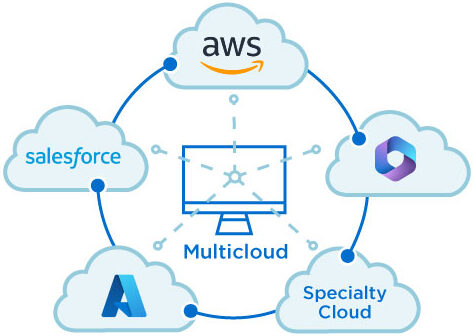
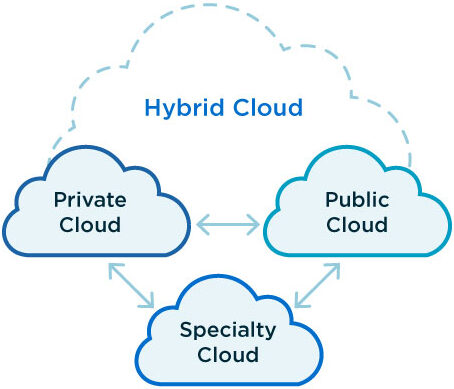
Benefits of specialty cloud
If a company doesn’t want to host their architecture on-premises, it can entrust a managed service provider to run its entire IT infrastructure stack in a specialty cloud environment. This requires total trust and transparency between the business and the managed service provider.
Specialty cloud also allows you to:
- Benefit from cloud solutions without rearchitecting
- Integrate technologies and tailor your environment to your needs
- Protect sensitive data that isn’t safe in a shared environment
What are most companies using for their infrastructure?
Today, a vast mix of companies use multi and hybrid cloud. Nearly every business is using a public cloud provider of some type. For example, Microsoft requires cloud access for Office 365 products. Most enterprises or large companies still have their IT footprint and haven’t fully migrated to the cloud. While specialty cloud is a fairly new cloud computing platform, it has gained momentum over the last few years.
Which solution is the best fit for your business?
Multi, hybrid and specialty cloud all create easy access to cloud computing. However, when choosing a cloud model for your workload or migrating your data to a new cloud, compare the pros and cons across cloud strategies to find the best fit for your specific business needs.
Are your workloads fit for public cloud?
Most businesses run a handful of workloads in public cloud. Several providers that dominate the public cloud space include AWS, Azure, and Google Cloud.
Cloud adoption has evolved to include multicloud deployments consisting of public and private clouds. Businesses leveraging multicloud rely on multiple cloud providers simultaneously, depending on their needs.
We now have businesses “born in the cloud,” taking full advantage of never owning any infrastructure and consuming what they need when they need it. More traditional organisations have wrestled with the burden of legacy IT workloads and focused on quick wins when moving to the cloud.
Getting the easy-to-move platforms and applications in the cloud first can result in 80% of volume in the cloud, leaving the remaining 20% taking 80% of the time due to legacy challenges. Or it may not even move in the long run, leaving some of the expected benefits of cloud (like shutting legacy data centres) unrealised.
What is fit for public cloud?
According to Amazon:
- Data storage, archive and backup
- Application hosting (CRM, email hosting, project management software, etc.)
- Latency-intolerant or mission-critical web tiers
- On-demand hosting for microsite and application
- Auto-scaling environment for large applications
All these run on the most common form of modern code tied to an underlying x86 architecture, so it’s ideal for startups to be “born in the cloud.” Workloads well suited for public cloud typically include test and dev environments for industries with low regulation and compliance requirements.
The cloud migration challenge
The challenge of workloads not fitting in public cloud often affects organisations operating for over 20 years with one or more core applications based on older proprietary hardware systems. They may have already moved workloads to public cloud but are left with legacy workloads or technical debt in their data centres.
To complicate matters further, they can face roadblocks with regulations and compliance. It’s also possible that they’ve lost the skills to support the day-to-day operations of legacy workloads and platforms. This technical deficit makes migrating workloads to public cloud seem impossible from a cost and complexity viewpoint.
Most companies revert to the traditional cycle of upgrading their underlying technology every 3–5 years to deflect these challenges.
How does specialty cloud address this challenge?
Organisations accepting a multicloud approach are relying on specialty cloud providers for a cloud option that addresses legacy technology debt and can provide some, if not all, the expected benefits of public cloud. Specialty cloud providers can solve not only the issues with the technology platform but also the skill gap needed to migrate workloads to the cloud. Migration is the most critical and least considered part of a specialty cloud move but presents the greatest organisational risk.
Service Express has taken our extensive skill set and built our own Specialty Cloud for IBM Power solution to support organisations running workloads on IBM® Power platforms with IBM i, AIX and Linux operating systems (OS).
We’ve helped countless customers — from all industries, often highly regulated with testing compliance requirements — over the last 30 years move IBM Power workloads to a flexible, reliable, scalable and resilient cloud platform. Our latest iteration based on IBM Power10 technology allows our IBM platform customers to run workloads in a cloud built on enterprise-class hardware, a genuine alternative to simply following the refresh cycle. Connect with us to learn more about your cloud options.
How to maintain hyperconverged infrastructure
Hyperconverged infrastructure (HCI) has revolutionised the IT landscape, offering streamlined operations and scalability. This blog explores the challenges of maintaining HCI and why third-party maintenance (TPM) is a viable solution.
What is hyperconverged infrastructure?
HCI is a single software-defined platform that integrates the same components as converged infrastructure (CI) into one system. In addition to enhancing scalability, this type of infrastructure can improve performance and reduce costs. Discover more about the differences between converged and hyperconverged infrastructure.
Challenges of hyperconverged infrastructure
Maintaining HCI poses unique challenges, including frequent updates and complex layered software.
HCI environments often face the dilemma of keeping pace with frequent software and hardware updates. Failure to stay current can lead to performance issues and security vulnerabilities.
In addition, HCI solutions often utilise layered software, requiring a specialised skill set for effective servicing. Expert knowledge is crucial for handling complexities introduced by plugins and software layers, especially when maintaining infrastructure spanning multiple manufacturers.
The importance of planning for proper maintenance
Efficient maintenance begins with strategic planning. Organisations must go beyond a reactive approach and embrace proactive strategies. Proper maintenance planning extends the lifecycle of HCI components, maximising the return on investment.
Benefits of third-party maintenance for hyperconverged infrastructure
TPM can be a strategic choice for addressing the complexities of maintaining HCI.
Compared to OEM maintenance, TPM providers can offer significant cost savings. This means organisations can maintain their HCI configurations without compromising quality or budgets.
A reputable TPM provider brings a wealth of experience and a proven track record in maintaining diverse HCI environments. Service Express engineers possess a broad skill set to support various HCI solutions and are well-versed in handling HCI complexities and providing comprehensive maintenance services.
Our team has completed extensive research and development on HCI through breaking, fixing and relocating equipment in our research labs. This enables our engineers to develop and enhance the skills needed to maintain and service major players in the HCI space.
Service Express specialises in supporting various HCI solutions, including Cisco Hyperflex, Dell EMC VxRail, HPE SimpliVity and Nutanix NX appliances. Our experts are equipped to navigate the nuances of these systems, ensuring reliable and efficient maintenance.
Leveraging a trusted maintenance partner
In the dynamic realm of HCI, strategic maintenance planning is crucial. Choosing a TPM provider for your maintenance strategy delivers cost savings and places your infrastructure with experienced professionals. With a proven track record and expertise in various HCI configurations, Service Express stands out as a reliable partner for organisations seeking seamless and effective maintenance.
By embracing TPM, organisations can confidently navigate the complexities of maintaining their HCI environments, ensuring continuous innovation and optimal performance.
IBM i subscription model key takeaways
How we consume software is changing as companies move away from individual licences that never expire to subscriptions. This trend is increasingly popular among investors due to its recurring revenue model, so I expect to see it continue.
Similar to other providers in the IBM i community, IBM will begin migrating its customers to subscription licences. The days of transferring your IBM i licences end with this change; effective May 7, 2024, you’ll no longer have the option to transfer your licence to a new Power® system with a tier P05 or P10. Although there hasn’t been an announcement for the P20 and P30 tiers, we’re certain those changes are coming — we just don’t know when.
How we got here
In May 2022, IBM announced that the IBM i software subscription would be available as an alternative to non-expiring licences. In February 2023, the subscription became available for P05, P10 and P20 tiers and Merlin (Modernisation Engine for Lifecycle Manager). In May 2023, the RDi and RDS LPPs were also available by subscription. All of this was optional, giving customers a choice.
The announcement in August 2023 focused on transitioning non-expiring licence customers to subscription licencing. The first step is withdrawing non-expiring licences for P05 and P10 tiers, effective May 7, 2024. If you have a P05 or P10 tier licence and purchase new hardware after this date, you’ll receive a subscription licence instead of completing a licence transfer.
What is the IBM i subscription model?
The IBM i subscription is available for Power9 and Power10 and supports 7.2, 7.3, 7.4 and 7.5, including your core licence, users, zero-dollar LPPs and software maintenance. Maintenance is standard Monday through Friday, 9–5 support, which you can upgrade to complete 24/7 support. Like maintenance, you can select a term between one and five years. The entry point is lower than a non-expiring licence.
You can add LPPs with a cost, such as Merlin, RDi and RDS, to your subscription. IBM announced on January 9 that BRMS (Backup, Recovery and Media Services for i) is now available by subscription, along with IBM Cloud Storage for i. Cloud Object Storage is available as a 90-day option for migration projects. IBM plans to make all LPPs available by subscription.
How does it affect my organisation?
This won’t affect you if you have an active maintenance agreement and don’t plan to upgrade to new hardware in 2024. IBM’s statement of direction indicates that IBM will offer a lower-priced subscription for customers with non-expiring licences for active software maintenance. So far, we don’t know what that’ll look like; we’re waiting to hear more from IBM.
Benefits of an IBM i subscription licence
There are benefits to having a subscription licence over a non-expiring licence. Board members, directors and executives like subscription terms because they make budgeting more manageable and predictable. Subscriptions can help eliminate missed software maintenance payments through auto-renew and offer a lower entry point for new customers. Smaller companies with lapsed software maintenance may save money by moving to subscription pricing and avoiding after-licence fees. The other significant benefit for everyone is that the licence is portable to a new system. You can maintain the term — and lower cost — you already paid for when you upgrade.
We don’t know all the details yet, but we’ll keep you updated as we learn more. We do know that acquiring a new Power10 before May 7, 2024, will save you money. If you’re considering a new Power10 in 2024, connect with us to discuss your options sooner rather than later.
Changing your IBM Business Partner
I can’t count how often I’ve heard someone say, “I wish I could use Service Express as our IBM Business Partner, but…”
Many customers think they’re forever tied to their IBM Business Partner, bound by an unwritten contract, so they can’t work with anyone else.
This is false.
While there are rules that IBM Business Partners must adhere to, for the most part, if someone wants to work with a new partner, nothing’s stopping them. Most new customers come to us the old-fashioned way: word of mouth. One customer works with us and tells people in their local IBM i community. And then one good turn deserves another.
Other times, partners go out of business or stop doing what they should: representing IBM to their customer base. I worked with a customer in 2019 who hadn’t heard from their partner in seven years since they installed their Power7.
Who did they call when they needed help? Service Express.
Simply because they knew we’re responsive and ready to help. We earned their business by dragging their system off the fire one night when their old IBM Business Partner didn’t pick up the phone. I don’t even think we charged them for the hour. All’s fair in love and war, I suppose.
Your IBM Business Partner can be located anywhere
Perhaps it’s out of habit, location or a combination of both. A company has used an IBM Business Partner for ~25 years and thinks they’re the only one in town. While that may be true to some extent, what’s even more true is that you don’t need a local partner anymore. If the pandemic has taught us anything, it’s that people can and do work from everywhere. That’s why we help customers with services worldwide.
While we can only provide IBM hardware in North America and Europe, we’ll gladly work with and recommend other reputable hardware resellers from Belgrade to Bangkok and everywhere in between.
Busting IBM Business Partner myths
While most IBM Business Partners are made up of honest folks, sometimes you hear flat-out nonsense that some partners try to get away with telling their customers — and they sometimes succeed, too.
Things like, “Our current IBM Business Partner says only they can upgrade our system,” or “We need our current IBM Business Partner to sell us a new system because they won’t issue us any licence keys to their software if they don’t.”
The former is utter foolishness. Anyone can do an IBM i upgrade. We just happen to arguably do more OS upgrades than anyone and have it down to a science. When IBM comes out with a new IBM i release, we’ve already upgraded it roughly forty times as part of the beta team, while most other partners are first reading the Memo to Users for that release.
We’ve already provided our input and helped determine features and functionality in the new operating system as part of the COMMON Americas Advisory Council and the IBM Champion programme, sometimes a couple of years in advance. We know what’s new because we helped define what it should look like through our involvement in advocacy groups. And that’s down to the bare metal; I remember discussing the chassis size of Power10 units a few months before that line of servers was announced!
The latter is a little more complicated when referring to licence keys. I’ve seen firsthand where a partner, who is also a customer’s software vendor, will protect their investment by holding licence keys hostage if they attempt to use another partner. And the customer is trapped to some degree. It’s unfortunate and unethical, but it does happen. I’ve also seen those software vendor partners inflate the cost of new hardware to force their customers into their cloud.
I remember a few years ago when we were asked to give a second opinion on a machine configuration. It should’ve been a simple box that probably would’ve cost around $50,000 list price, coming from a small P05 Power7 with eight disk drives, 32 GB RAM, a four-processor core machine with one IBM i licence and unlimited users. They also needed a new tape unit. What was the cost for the proposed configuration they received? Over $250,000. The other partner configured five or six licences of IBM i on an eight-core Power9, quadrupled the RAM, maxed out the system unit with SSDs and surprisingly added an expansion drawer for more SSDs.
We knew the customer was in a pickle and did what anyone with an inkling of decency would do: we configured a properly sized box that cost about $50,000, including the tape unit, and gave it to the customer with my compliments. Then, I called the proper channels at IBM and told them what the other partner was doing. Nobody should be given the gears like that customer was. It’s neither ethical nor moral and violates the Business Partner Agreement.
Do you know what usually happens in a situation like that? After a conversation with us, a customer may be forced to buy a server from their old partner (with our properly sized configuration recommendations) but come to us for the migration services. We start building that relationship by doing the upgrades and answering the calls when the customer needs trusted advice.
Who cares if we don’t sell a machine? Big deal. The customer knows the configuration is solid, and they’re not getting ripped off. We’ll always review the old partner’s proposed configuration and turn it into Swiss cheese if they’re trying to sneak in an extra Ethernet card the customer doesn’t need — because that’s what a partner does.
IBM i education from your Business Partner
What about education? If your partner isn’t providing you with hundreds of hours of complimentary educational content every year for your benefit, you should give us a call.
Forget about your education for a second. When was the last time your existing partner educated themselves? It’s funny because when we do webinars, we see other partners on them, and that’s cool with us. There are plenty of partners that do a great job, and we happily break bread and consult with many of them. Sometimes they need help, and sometimes we need help. That’s how good working relationships work. We know many customers who can teach some partners about IBM i 7.4 features. We have a pretty good idea of which partners aren’t keeping their skills sharp based on some of the configurations we give second opinions on.
Say it with me: production servers don’t need 10k RPM spinning disks in their SAN purchase. Yes, we still see that, not for historical low-I/O data but for production workloads. I hope their customers aren’t expecting things like performance.
So, how do you change your IBM Business Partner?
It all starts with a call or an email. Then, we start working together as a partnership. It’s nothing more complicated than that. With that in mind, we hope to hear from you soon and will continuously strive to earn your business.
Switching to Service Express as your business partner is like turning on the lights to value you didn’t even know was there. Let us shine a light on your IBM i possibilities — it’s as easy as flipping a switch. Contact us.
Adopting generative AI in the data centre
As economic uncertainty continues, cost reduction remains an ever-present goal among global organisations. Adopting strategies to streamline processes, optimise spending and maintain resiliency is crucial for businesses within the IT and data centre space. With IT and finance departments at the forefront, developing and implementing efficient strategies are imperative.
AI: A tool for efficiency
Companies are feeling the pressure to drive efficiency through data and automation, where generative AI can be an effective solution. Many CIOs already implement generative AI by utilizing ChatGPT and other tools to enhance workstreams. According to a 2023 report by Freshworks, over 90% of IT directors and upper management use AI to support their work.
Nearly half of IT professionals agree that this technology significantly reduces their workloads, saving more than five hours per week, according to Freshworks. As software providers continue integrating AI capabilities into their offerings, now is the time for experimentation to discover where AI fits in your company strategy.
What is generative AI?
Generative AI is a subset of artificial intelligence that focuses on creating content in text, images, music or videos. At the core, generative AI models understand patterns in data and generate new, similar data based on what they’ve learned. This process isn’t about direct replication but about understanding the underlying structure and nuances of the input data to produce fresh, unique outputs.
Although generative AI is still in its early phases, its evolving capabilities can substantially change business operations. In the future, AI may write code, design new drugs, develop products and transform processes like supply chains.
Key components of generative AI:
- Training: The model is exposed to vast amounts of data to understand patterns and variations within the data.
- Generation: Once trained, the model can produce new content that reflects these patterns and structures.
- Applications: Generative AI finds applications in various fields, from creating artwork to generating music, simulating realistic human voices and even designing innovative products.
How organisations can leverage generative AI
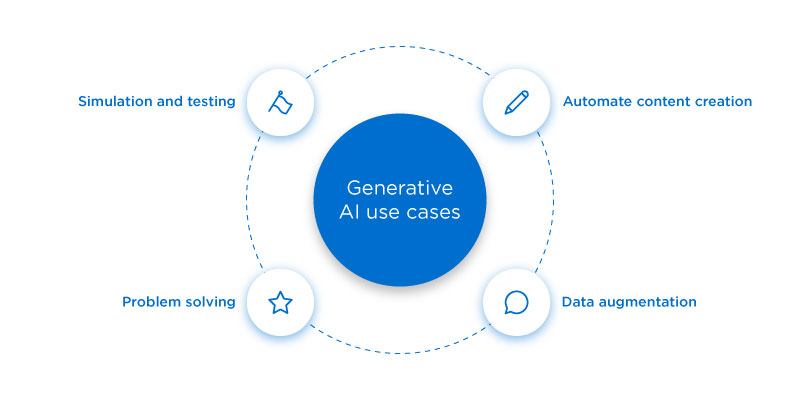
Generative AI can play several pivotal roles when it comes to IT organisations:
- Automate content creation: IT companies with large-scale content creation can leverage generative AI to produce drafts or templates, speeding up content production.
- Data augmentation: For organisations that work with machine learning, generative AI can create additional training data, enhancing the robustness of other models.
- Simulation and testing: In software development and testing phases, generative AI can produce various user inputs or scenarios to test the robustness and flexibility of software solutions.
- Innovative problem solving: Generative models can brainstorm and generate solutions or approaches that might not be immediately evident to human developers, opening doors to innovation.
Further, data centres are uniquely positioned to benefit from generative AI and advance operations through:
- Predictive analytics that optimise power usage and network traffic, adding efficiencies and improving resource management
- Enhanced security that detects issues and threats in real-time
- Predictive maintenance and workload management that improves service delivery and minimises downtime
For example, predictive analytics can combat the substantial heat that computing demands produce. Operators can use AI to cool hardware more efficiently, reducing costs and improving energy efficiency. Predictive analytics can reduce infrastructure inefficiencies by fine-tuning power allocation and rack space to cut operational costs and improve power usage effectiveness (PUE).
Navigating forward: Strategic and cautious AI adoption
Cost reduction amidst economic constraints is a shared goal across the industry. With the right strategy, minimising costs while propelling business growth is possible. The journey begins with collaboration among stakeholders, an understanding of top priorities, and strategic AI integration to unlock value, surpass expectations and achieve business objectives.
Implementing generative AI in data centres not only presents an opportunity to enhance efficiency and reduce costs but also positions organisations to be more resilient and adaptable in facing future economic challenges. With careful planning and execution, AI can be a valuable ally in navigating economic downturns while ensuring data centres continue to operate efficiently and effectively. The IT industry must continue to evolve to support emerging data centre challenges and maximise generative AI’s potential.
Why Specialty Cloud for IBM Power has the right ingredients for your critical applications
Recently, our household found ourselves stuck in a monotonous dinner routine. In search of excitement, we decided to try a meal kit delivery service.
While we could easily buy all the items separately, the kits offer something more. They come with high-quality ingredients in perfect portions, reducing our food waste and introducing us to new, tantalising recipes crafted by culinary experts. This shift in our daily dining spiced up our meals and sparked a realisation. Combining individual elements to create something greater mirrors the principles we see in the IT world.
Pre-packaged ingredients for your cloud solution
In the same way we rejuvenated our dinner routine and introduced a zest of novelty and expertise with a meal kit delivery subscription, we crafted the Specialty Cloud for IBM Power solution to invigorate the business technology landscape. This innovation is more than a simple meal of services; it’s an experience tailored to fit modern enterprises’ dynamic and sophisticated palates.
Specialty Cloud for IBM Power embodies the evolution of IT solutions, transcending traditional service boundaries to prioritise the stability, performance and integration of businesses’ critical applications. Synergising essential services such as Infrastructure as a Service (IaaS), Infrastructure Security, Managed Operating Systems and Managed Backup and Recovery creates a unified solution to enhance efficiency and cohesiveness for an enterprise’s vital operations, regardless of size.
Why dig into Specialty Cloud?
Emphasising time efficiency and scalability, Specialty Cloud stands at the forefront of business technology, propelling rapid deployment and facilitating swift adaptation to changing market demands. It’s not simply a feature but an intrinsic business strategy, offering a competitive advantage in the marketplace.
The solution is built on unwavering reliability and promises consistent performance and quality. Businesses can thus focus on their core activities, reassured by a stable and reliable IT infrastructure.
IBM i users have long grappled with extensive maintenance windows that disrupt business continuity. Recognising this pain point, Specialty Cloud for IBM Power has made significant strides in shrinking these windows to mere slivers of time. This advancement exemplifies Service Express’ commitment to innovation and represents a pivotal shift towards minimising downtime. Businesses can now enjoy a smoother, more reliable operation of their IBM Power infrastructure, a marked improvement that reflects our dedication to continuously elevating user experience.
The secret sauce for your critical applications
Sustainability is a cornerstone of the cloud solution, operationalised through its deployment in eco-friendly availability zones renowned for their exceptional energy efficiency. This strategic decision underscores dedication to environmental stewardship, aligning with broader objectives of resource conservation and carbon footprint reduction.
The solution reduces its impact while achieving operational excellence by harnessing the latest green technology and energy-saving practices. The balance between environmental mindfulness and peak performance exemplifies a forward-thinking approach, ensuring business operations are optimised for maximum output and leave the smallest possible environmental imprint.
The security framework within Specialty Cloud is designed to fortify operational integrity and confidentiality, bolstering IBM i, AIX, Linux and Microsoft Windows operating environments. By integrating advanced security measures, the platform guarantees uninterrupted and secure operations. Features such as robust encryption protocols, fortified firewalls and vigilant, ongoing system updates create a layered defensive strategy, enhancing the protection of your data and applications from potential threats. This approach cultivates a secure and resilient operational environment, reinforcing trust and stability within your IT infrastructure.
Your cloud solution is served
Just as our household’s foray into meal kit delivery transformed mundane dinners into culinary adventures, our Specialty Cloud for IBM Power solution promises to transform your IT infrastructure. It’s a partnership aimed at nurturing your business’s growth with innovation and a shared commitment to success — savouring the journey towards a future where your business goals and our technological expertise blend into the perfect recipe.
2024 Data Centre & Infrastructure Report

2024 Data Centre & Infrastructure Report
Discover how and why your IT peers are taking actions and making plans for effective data centre and infrastructure management.
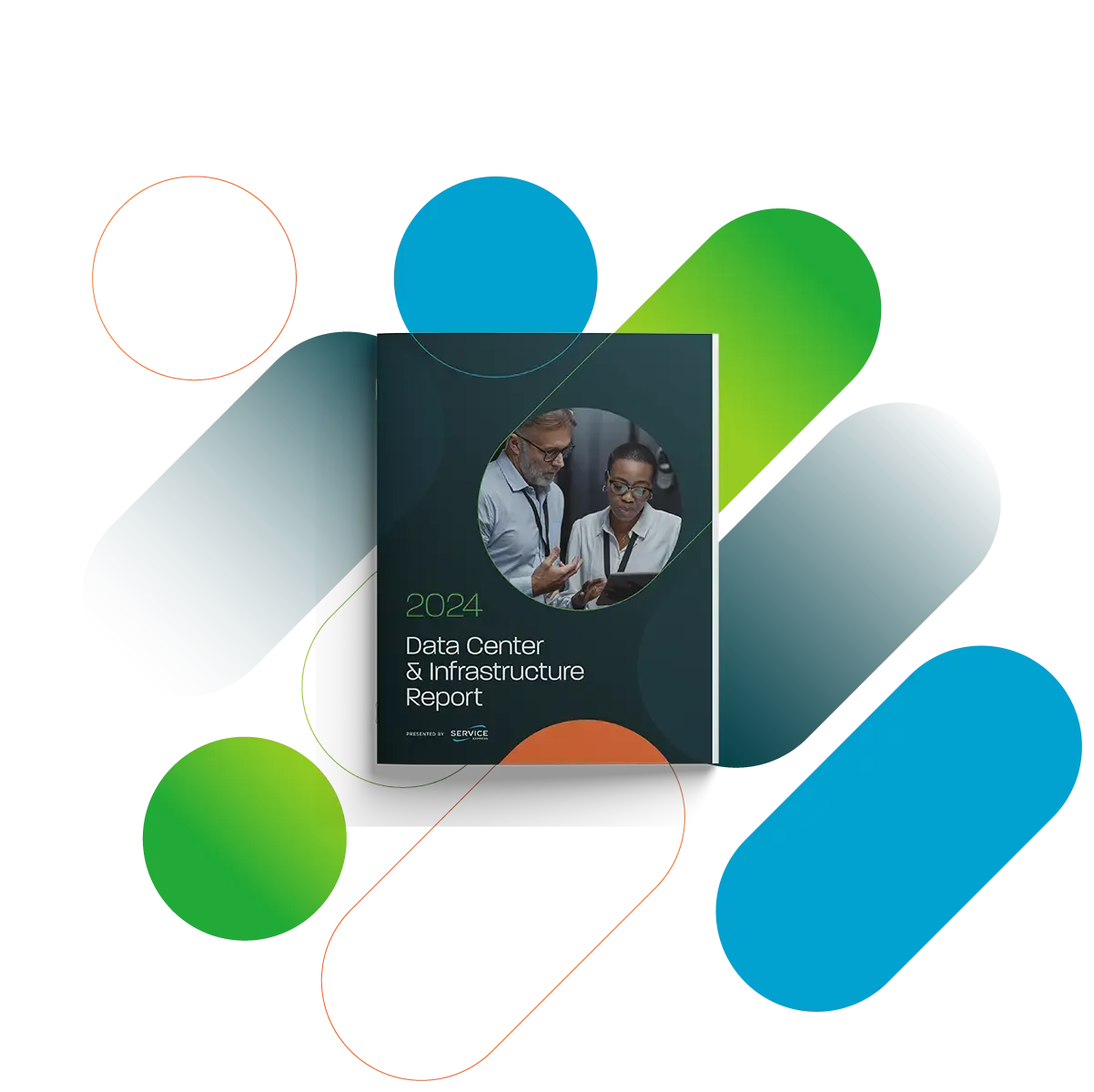
Priorities and challenges
Budget outlook
Workload deployment
Infrastructure hardware
Data centre maintenance
Managed services
Sustainability
Human capital
Priorities and challenges
Budget outlook
Workload deployment
Infrastructure hardware
Data centre maintenance
Managed services
Sustainability
Human capital
As a global data centre and infrastructure solutions company, we’re interested in how organisations manage their data centres and infrastructure worldwide. Explore the responses and expert insights shared in our clear and concise annual report.
Key findings
To be successful, IT leaders must maximise budgets, implement balanced hybrid workloads and work to meet future environmental standards.
#1

Master your budget management expertise
Despite ongoing budgetary constraints, IT leaders are expected to deliver more services every year. This expectation poses major challenges as complexity increases for staffing demands, infrastructure investments and cloud costs.
#2

Find the right balance in your hybrid deployment strategy
As IT leaders draw on more firsthand hybrid experience, they’re reevaluating where to house workloads, where to achieve the best performance and how to implement the most cost-efficient environment.
#3

Act on the growing commitment to sustainability
The impact of data centre and infrastructure sustainability is directing more IT decisions toward alignment with business needs, corporate responsibility and environmental goals.




Priorities and challenges
Focusing on top priorities
The leading priorities for IT teams have remained consistent over the past five years. Implementing automation can streamline processes to free up employee resources and IT budgets. Direct the savings gained toward security efforts and employee initiatives.
Top priority
Strengthening
security
45%
Strengthening security
45%
Improving internal processes
35%
Developing IT team members
34%
Reducing IT Costs
34%
See all responses in the full report.
Budget outlook
Saving IT dollars
Longer equipment life is helping companies stretch IT budgets. Teams are also consolidating workloads and exploring hybrid, public and private cloud solutions to reduce spending.
Top measure
Extending
equipment life
48%
See all responses in the full report.
2024 Data Centre & Infrastructure Report
Get ready for what’s next
Take a moment to see how IT professionals are preparing for challenges and success in 2024.
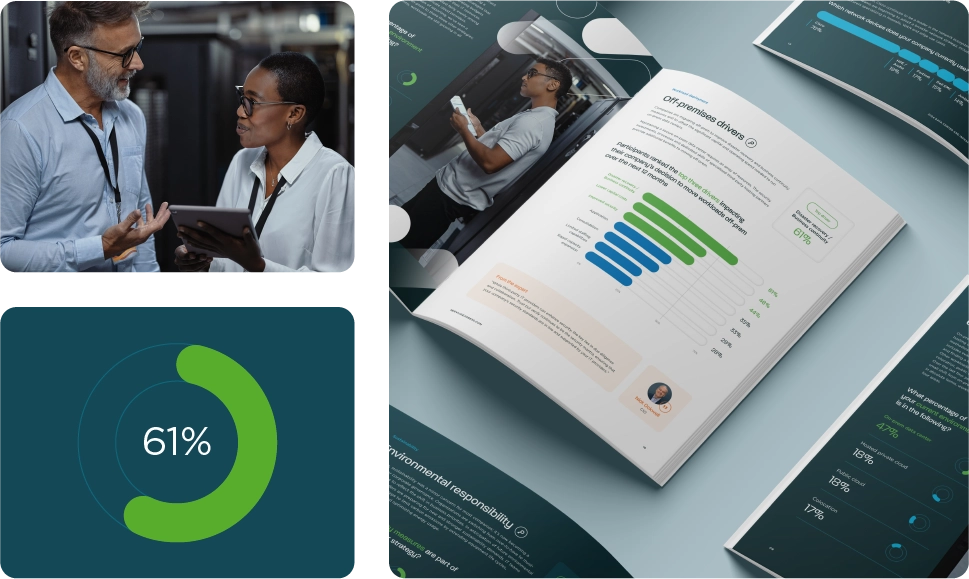
Forterra makes substantial productivity gains by migrating to a Specialty Cloud solution
Forterra is a leading UK manufacturer of bricks, blocks, precast concrete, paving and many other vital construction products and services. The company relies on a wide range of IT infrastructure to support its product development, manufacturing and operations.
Combatting outages from an unresponsive colocation provide
Forterra hosted its infrastructure at a facility in Germany. Over time, Forterra experienced technical roadblocks, slow response times and outdated multiprotocol label switching (MPLS) networks. Due to the routine outages and complications, Forterra partnered with Service Express to transfer its IBM i logical partition (LPAR) from Germany to the UK.
Establishing a new and reliable home for IT infrastructure
After multiple discovery meetings, Service Express identified the company’s need to redirect its IT team’s time and resources to other core areas of the business. Instead of creating a single LPAR, Forterra migrated 91 virtual machines (VMs) into Service Express’ data centre. Service Express’ technical teams handled the migration in phases outside of regular working hours and during weekends. The migration from start to finish spanned several months.
Industry:
Construction Materials
Location:
Northampton, UK
Service: Specialty Cloud for IBM Power Solution
“Service Express has delivered on its promises for cost savings, increased availability, scalable solutions and fantastic service. It’s a genuine pleasure to work with their team and I’d like to thank them for making my team’s jobs a lot easier.”
– Paul Inman, IT Director, Forterra
“Our environment was migrated with zero outages,” said Paul Inman. “Excellent service was provided and still is. So much so, we have considerably more VMs at Service Express than we originally planned due to physical to virtual (P2V) migrations.”
Improved uptime and productivity
By migrating systems to Service Express, Forterra has observed several improvements.
- Increase in availability and system performance speeds
- Simplified system administration
- Strengthened productivity with new MPLS network connection
“We have realised a triple-digit cost saving,” says Paul Inman. “The faster VMs and MPLS network connections have all provided for increased productivity.”
Looking ahead to the future
Service Express currently monitors and maintains Forterra’s suite of data centre and MPLS services and over 125 of the company’s VMs. Forterra’s team is pleased with the process from start to finish, and they look forward to additional projects in the future.
IBM Power8 End of Service Life (EOSL): What’s next for your hardware?
On November 15, 2022, IBM formally announced End of Service Life (EOSL) dates for select Power8 scale-out and scale-up systems. Depending on the machine type and model, the effective EOSL date may fall between March and October 2024.
What does EOSL mean?
In simple terms, EOSL for Power8 means IBM will no longer offer hardware upgrades, firmware updates or maintenance services for the designated models.
The IBM announcement states, “Selected machine types, models, and features will be discontinued from maintenance services. IBM will send no further correspondence of this nature for these machine types, models, features, or RPQs. After the effective date, IBM will no longer offer full hardware maintenance service for the listed machine types. If available, clients will continue to receive limited hardware maintenance service.”
Recently, we’ve seen a significant price increase in IBM’s extended hardware maintenance costs. So once your Power8 model approaches its EOSL date, anticipate additional price increases and limited response times based on parts availability.
What are your options?
According to an IBM i marketplace survey, 60% of the total IBM i installed is on Power8 or later generations (that’s a substantial number of customers). On the bright side, IBM has given organisations the time to plan, strategise and budget for their next hardware refresh. Now’s the time to begin planning your hardware refresh from Power8 to the newer technologies IBM has heavily invested in over the years. Below are several options to help you move forward and understand what’s next for your Power8 hardware.
- Refresh to Power10
- Migrate to Cloud
- Continue running your Power8 hardware with IBM third-party maintenance (TPM)
If you’re unsure of the right option for your business, we’re here to provide your team with recommendations based on your unique needs.
If your organisation has a Power8 or older system and would like to discuss your migration, maintenance, or refresh options, we’re here to help you understand the next steps for your hardware. For expert guidance, contact us here.
